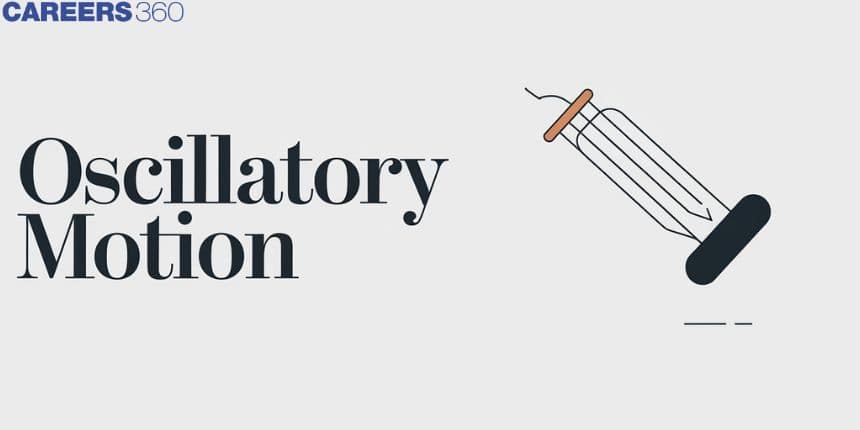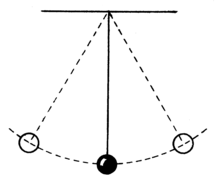Oscillatory Motion - Definition, Examples, Types, FAQs
Oscillations and waves are all around us, whether we notice them or not. An oscillation is a motion that repeats itself over time, like a pendulum swinging back and forth, while a wave is a disturbance that repeats both in time and space, such as sound or light waves. Anything that moves to and fro is oscillating and when many such oscillations combine they form a wave. In this article, you will learn the fundamentals of oscillatory motion, its types including simple harmonic motion, examples the difference between oscillatory and periodic motion and answer some frequently asked questions(FAQs) to give you a clear understanding of the topic.
This Story also Contains
- What is Oscillatory Motion?
- Examples of Oscillatory Motion
- Types of Oscillatory Motion
- Characteristics of Oscillatory Motion
- What is Periodic Motion
- The Difference Between Periodic Motion and Oscillatory Motion

Also read:
What is Oscillatory Motion?
Definition: An oscillatory motion is a to-and-fro or back-and-forth motion of a body about a fixed position or mean position.
In this motion, the body repeats its path at regular intervals of time.
Examples of Oscillatory Motion
- Motion of a simple pendulum
- Vibrating strings of a guitar
- Oscillation of a tuning fork
- The motion of a swing
- Spring mass system
- Bungee jumping
- A suspension bridge under variable load
Types of Oscillatory Motion
Based on the nature of motion, oscillatory motion can be classified into two types:
- Linear Oscillatory Motion
- Circular Oscillatory Motion
Linear Oscillatory Motion
The oscillatory motion occurs in a linear path ( straight line) around the equilibrium position. The displacement is measured in meters or any unit of length. The restoring force is proportional to the displacement.
$
F=-k x
$
Examples of linear oscillatory motion
- Spring-mass system
- Vibration on a string
- The piston in an engine
- Bungee jumping
Circular Oscillatory Motion
The oscillatory motion is in back-and-forth rotation about a fixed axis. The displacement is measured as an angle. The restoring torque is proportional to the angular displacement.
$
\tau=-k \theta
$
Examples of Circular Oscillatory Motion
- Swinging doors
- Rotating flywheel
- Balance wheel in clocks
Characteristics of Oscillatory Motion
- Oscillatory motion occurs at a fixed point where the net force acting is zero. This position is called the equilibrium position.
- The fixed interval of time at which the oscillatory motion repeats itself is called the time period.
- The maximum displacement from the equilibrium position called amplitude measures the extent of oscillation.
- Frequency is the number of oscillations completed per second.
$$f=\frac{1}{T}$$
- Oscillatory systems have both kinetic energy and potential energy.
.png)
Simple Harmonic Motion
Simple harmonic motion is a type of oscillatory motion in which Hooke's law is obeyed. In this motion, the restoring force is directly proportional and opposite to the displacement from the equilibrium position of the motion.
$
F=-k x
$
where,
- $F$ is the spring's restoring elastic force ($N$),
- $k$ is the spring constant ($\mathrm{Nm}^{-1}$),
- $x$ is the displacement from the equilibrium position ($m$)
Examples of SHM
- Vibrating strings
- LC circuit
- Torsional pendulum
The oscillatory motion's equilibrium position is the place at which oscillations occur, and the oscillating object must pass through this point during each oscillation. The oscillating object comes to a stop at this point after some time when the oscillatory motion stops due to friction in the medium in which it is oscillating.
Vibration is a term used to describe objects that oscillate. There isn't much of a distinction between these two terms. However, in general, when an object moves at high frequencies, it is said to be vibrating, and when it moves at low frequencies, it is said to be oscillating.
To and Fro Motion
The forward and backward movement of an object around an equilibrium point is referred to as to and fro. A pendulum, for example, travels from one side to the other before returning to its original position. To and fro motion is the term for this type of movement.

What is Periodic Motion
Definition: A periodic motion is a motion that repeats itself at regular intervals of time.
In this type of motion, a body moves in such a way that its position, velocity, and acceleration repeat after a fixed time period.
Examples:
- The revolution of the Earth around the Sun (1 year).
- The rotation of the Earth about its axis (1 day).
- The motion of a pendulum.
- The vibration of a tuning fork.
The Difference Between Periodic Motion and Oscillatory Motion
The differences between oscillatory and periodic motions are given in the table below:
| Periodic Motion | Oscillatory Motion |
| Motion that repeats itself at regular intervals of time. | A type of periodic motion where an object moves back and forth about an equilibrium position. |
| Can be linear, circular, or oscillatory. | Always involves back-and-forth motion. |
| Not necessarily about an equilibrium position. | Always occurs around a fixed equilibrium position. |
| Earth's revolution around the Sun, rotation of a wheel. | Motion of a pendulum, vibration of a spring. |
| Periodic motion is not always oscillatory. | Oscillatory motion is always periodic. |
Related Topics,
Frequently Asked Questions (FAQs)
SHM is a type of oscillatory motion where the restoring force is directly proportional to the displacement and directed towards the mean position. Examples: spring-mass system, simple pendulum (small angles).
Examples include: pendulum of a clock, a child on a swing, vibration of a guitar string, tuning fork, mass-spring system, heartbeat, ocean waves, sound waves, violin string, and motion of a piston.
Oscillatory motion – motion back and forth about a mean position.
Periodic motion – motion that repeats at regular time intervals; oscillatory motion is a type of periodic motion.
An oscillatory motion is one in which an item moves in such a way that it periodically comes to and leaves a fixed point. The equilibrium point is this fixed position. The oscillatory motion's equilibrium position is the place at which oscillations occur, and the oscillating object must pass through this point during each oscillation. Electromagnetic waves, alternating current circuits, and molecular motion are all examples of this.
“The restoring force is directly proportional to the displacement from the equilibrium position,” according to Hooke's law. A spring is linked to a block and fixed to the wall on a horizontal plane, and the block is placed in such a way that it can move horizontally. When the block slides horizontally away from the wall, the spring strives to recover its position, resulting in oscillatory motion. The restoring force attempts to prevent distortion of the spring. This restorative force comes from
The negative sign in Fs=–kx indicates that the force is acting in the opposite direction of the displacement x. This is known as Hooke's law.
Many phenomena, including electromagnetic waves, alternating current circuits, and molecules, require this motion to be studied. Two conditions must be present for a vibration to occur: stiffness and inertia.
"Oscillatory motion" is motion that repeats over and again after a time T called the "period," and is also known as "periodic motion" with a time T termed the "repeat time."
The force in an oscillating system always works in the opposite direction as the particle's movement from the equilibrium point. A restorative force is a force that is either constant or varies with time or position. The ensuing motion is oscillatory as long as the force follows the aforementioned principle.